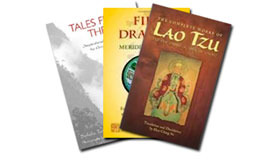Qigong Training
0“Dao that can be told, or described in words is not the Eternal Dao”. So begins the Daode Jing (Tao Te Ching) of Laozi (Lao Tzu), written some 2500 hundred years ago.
This book has become the most widely translated book in the world after the Bible. It contains much wisdom in its few pages. We will be quoting Laozi throughout this book. His writings are spare and poetic and leave much room for reflection.
How then to describe the indescribable? How to fit into words that which is beyond words? The Dao can only be pointed to, or referred to, say the ancient sages. It cannot be held, only experienced. It cannot be touched, only felt. It cannot be seen, only glimpsed, with the inner eye.
The term Dao is used to describe the indescribable, to put into words what is wordless, to give sound to the great silence. For the Dao is our source, our path, our end as it is our beginning.
The Chinese word Dao is made up of two characters. One means to follow or to run and the other is a human face. In this way it can be translated as a person moving along a path. It can also be thought of as the path or Way itself.
Dao is at once the universal pageant of the constellations and the budding of each new leaf in the spring. It is the constant round of life and death and all that falls between, an undying cycle of change and renewal.
While Dao is not personalized, it sustains all of creation, giving life and supporting the life of all living beings – human, plant, animal, water, even the very rock foundation of the earth itself. And, in the end, when we have shrugged off this mortal coil, we return to the bosom of the undifferentiated consciousness, the Dao.
The Path of Dao is dedicated to discovering the dance of the cosmos in the passing of each season as well as the passing of each precious moment in our lives.
By paying attention only to what you can see with your eyes you will miss seeing what is really there. It is only by seeing with the inner eye that one can see the true Way. By connecting to our eternal self, by finding a way back to our source, we can experience a sense of peace, of safety, and of harmony with the world around us.
The Path of Dao, with its emphasis on self cultivation and self responsibility and its many forms of energy work and exercise are perfect for today’s world.
The Dao is easy to lose, hard to find, impossible to describe, difficult to see, yet is ever before us, shining like a light in the darkness. Laozi said: “My words are easy to understand yet no one puts them into practice.”
The Ancient Achieved Masters
Once there lived men and women who were not conscious of their separation from Dao, therefore they were at one with it. Zhuangzi (Chuang Tzu), one of the important Daoist sages of ancient times, describes this kind of person as not minding being poor. They took no pride in their achievements. They made no plans. In this way, they could commit an error and not regret it. They could succeed without being proud. They could climb mountains without fear, enter water without getting wet, and pass through fire without being burned. They slept without dreaming and awoke without anxiety. Their food was simple and their breath was deep.
They did not love life or hate death. When they were born they felt no elation, when they died there was no sorrow. Carefree they came. Carefree they went. That was all. They did not forget their beginning yet did not seek their end. They accepted all that was given them with delight and when it was gone, they gave it no more thought.
Nowadays we strive and struggle, never content, always sure there is something greater to achieve, something of greater value and worth if only we can become successful in the eyes of the world. Yet at the end of the day, in the deep of the night, in the first glare of the morning light, we feel empty and bereft. We have lost the Way and are very far indeed from those ancient men and woman who lived so lightly and so well.


Comments